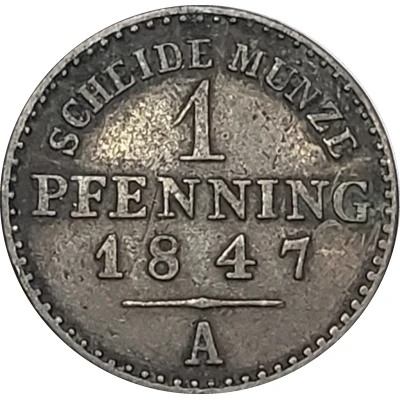


© munzhunter
1 Pfenning - Paul Frederick Emil Leopold III
| Copper | 1.5 g | 17.5 mm |
| Issuer | Principality of Lippe (Lippe, German States) |
|---|---|
| Prince | Leopold III (1851-1875) |
| Type | Standard circulation coin |
| Years | 1851-1858 |
| Value | 1 Pfennig (1⁄360) |
| Currency | Thaler (1838-1873) |
| Composition | Copper |
| Weight | 1.5 g |
| Diameter | 17.5 mm |
| Thickness | 1 mm |
| Shape | Round |
| Technique | Milled |
| Orientation | Medal alignment ↑↑ |
| Demonetized | Yes |
| Updated | 2024-10-05 |
| Numista | N#17844 |
|---|---|
| Rarity index | 34% |
Reverse
Value and date, legend around.
Script: Latin
Lettering:
SCHEIDE MÜNZE
1 PFENNING
1858
A
Edge
Plain
Comment
Lippe (later Lippe-Detmold and then again Lippe) was a historical state in Germany, ruled by the House of Lippe. It was located between the Weser river and the southeast part of the Teutoburg Forest.The founder of what would become the County of Lippe (1528–1789), then the Principality of Lippe (1789–1918) was Bernhard I, who received a grant of territory from Lothair III in 1123. Bernhard I assumed the title of Edler Herr zu Lippe (noble Lord to Lippe). The history of the dynasty and its further acquisitions of land really began with Bernard II. His territory was probably formed out of land he acquired on the destruction of the Duchy of Saxony following the demise of Henry the Lion in 1180. From 1196 to 1666 the descendants of Bernard II passed their holdings from father to sons for sixteen generations. Thereafter until 1905, a collateral branch passed Lippe from father to sons for eight generations. A distant relation then became the last ruler until the Revolution of 1918 when Lippe became the Free State of Lippe.[1] Simon V was the first ruler of Lippe to style himself as a count (Graf) in 1528.
Following the death of Simon VI in 1613, the county was partitioned between his three sons; Lippe-Detmold went to Simon VII, Lippe-Brake to Otto and Lippe-Alverdissen went to Philip I. The county of Lippe-Brake was reunited with the main Detmold line in 1709. Another branch of the family was founded by Jobst Herman, a son of Simon VII, who was founder of the Lippe-Biesterfeld line.[2] From this branch, the branch Lippe-Weissenfeld was later to be separated. Both the Counties of Lippe-Biesterfeld and Lippe-Weissenfeld were sold to the princely line of Lippe(-Detmold) in 1762.
The Counts of Lippe-Detmold were granted the title of Imperial prince in 1789.
Shortly after becoming a member state of the German Empire in 1871, the Lippe-Detmold line died out on 20 July 1895. This resulted in an inheritance dispute between the neighbouring principality of Schaumburg-Lippe and the Lippe-Biesterfeld line. The dispute was resolved by the Imperial Court in Leipzig in 1905, with the lands passing to the Lippe-Biesterfeld line who, until this point, had no territorial sovereignty.
The Principality of Lippe came to an end on 12 November 1918 with the abdication of Leopold IV, with Lippe becoming a Free State. In 1947, Lippe merged into the state of North Rhine-Westphalia. The princely family still owns the estate and Fürstliches Residenzschloss in Detmold.
Interesting fact
The 1 Pfenning coin from the Principality of Lippe, which was minted during the reign of Paul Frederick Emil Leopold III (1851-1858), features an image of the prince on one side and the Lippe coat of arms on the other. The coin was made of copper and weighed 1.5 grams. What's interesting is that the coin was minted during a time of economic and political change in the region. The Principality of Lippe was a small state within the German Confederation, and the coinage of the time reflected the political and economic ties between the various German states. The 1 Pfenning coin was a common denomination during this period, and it was used for everyday transactions within the Principality of Lippe and beyond.
Price
| Date | Mintage | VG | F | VF | XF | AU | UNC |
|---|---|---|---|---|---|---|---|
| 1851 A | 1080000 | - | - | - | - | - | - |
| 1858 A | 900000 | - | - | - | - | - | - |
Values in the table are based on evaluations by sales realized on Internet platforms. They serve as an indication only for 1 Pfenning - Paul Frederick Emil Leopold III 1851-1858 coin.



